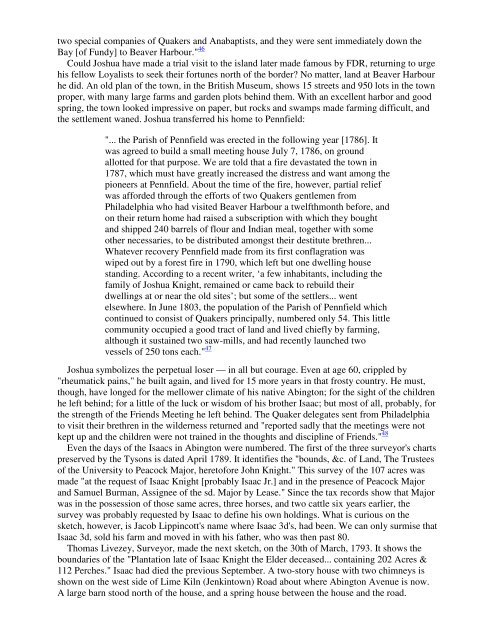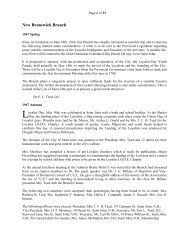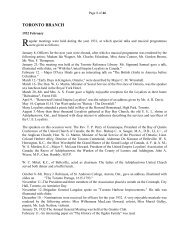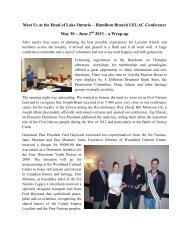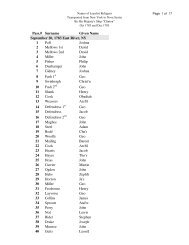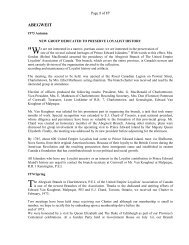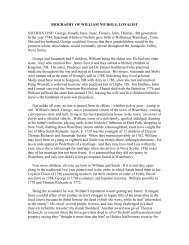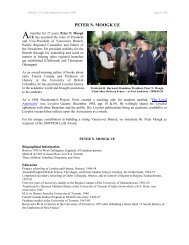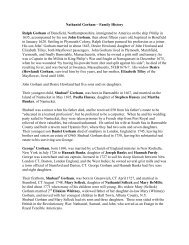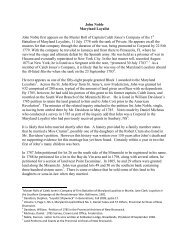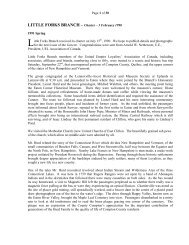Treason In Abington - for United Empire Loyalists
Treason In Abington - for United Empire Loyalists
Treason In Abington - for United Empire Loyalists
You also want an ePaper? Increase the reach of your titles
YUMPU automatically turns print PDFs into web optimized ePapers that Google loves.
two special companies of Quakers and Anabaptists, and they were sent immediately down the<br />
Bay [of Fundy] to Beaver Harbour." 46<br />
Could Joshua have made a trial visit to the island later made famous by FDR, returning to urge<br />
his fellow <strong>Loyalists</strong> to seek their <strong>for</strong>tunes north of the border? No matter, land at Beaver Harbour<br />
he did. An old plan of the town, in the British Museum, shows 15 streets and 950 lots in the town<br />
proper, with many large farms and garden plots behind them. With an excellent harbor and good<br />
spring, the town looked impressive on paper, but rocks and swamps made farming difficult, and<br />
the settlement waned. Joshua transferred his home to Pennfield:<br />
"... the Parish of Pennfield was erected in the following year [1786]. It<br />
was agreed to build a small meeting house July 7, 1786, on ground<br />
allotted <strong>for</strong> that purpose. We are told that a fire devastated the town in<br />
1787, which must have greatly increased the distress and want among the<br />
pioneers at Pennfield. About the time of the fire, however, partial relief<br />
was af<strong>for</strong>ded through the ef<strong>for</strong>ts of two Quakers gentlemen from<br />
Philadelphia who had visited Beaver Harbour a twelfthmonth be<strong>for</strong>e, and<br />
on their return home had raised a subscription with which they bought<br />
and shipped 240 barrels of flour and <strong>In</strong>dian meal, together with some<br />
other necessaries, to be distributed amongst their destitute brethren...<br />
Whatever recovery Pennfield made from its first conflagration was<br />
wiped out by a <strong>for</strong>est fire in 1790, which left but one dwelling house<br />
standing. According to a recent writer, ‘a few inhabitants, including the<br />
family of Joshua Knight, remained or came back to rebuild their<br />
dwellings at or near the old sites’; but some of the settlers... went<br />
elsewhere. <strong>In</strong> June 1803, the population of the Parish of Pennfield which<br />
continued to consist of Quakers principally, numbered only 54. This little<br />
community occupied a good tract of land and lived chiefly by farming,<br />
although it sustained two saw-mills, and had recently launched two<br />
vessels of 250 tons each." 47<br />
Joshua symbolizes the perpetual loser — in all but courage. Even at age 60, crippled by<br />
"rheumatick pains," he built again, and lived <strong>for</strong> 15 more years in that frosty country. He must,<br />
though, have longed <strong>for</strong> the mellower climate of his native <strong>Abington</strong>; <strong>for</strong> the sight of the children<br />
he left behind; <strong>for</strong> a little of the luck or wisdom of his brother Isaac; but most of all, probably, <strong>for</strong><br />
the strength of the Friends Meeting he left behind. The Quaker delegates sent from Philadelphia<br />
to visit their brethren in the wilderness returned and "reported sadly that the meetings were not<br />
kept up and the children were not trained in the thoughts and discipline of Friends." 48<br />
Even the days of the Isaacs in <strong>Abington</strong> were numbered. The first of the three surveyor's charts<br />
preserved by the Tysons is dated April 1789. It identifies the "bounds, &c. of Land, The Trustees<br />
of the University to Peacock Major, hereto<strong>for</strong>e John Knight." This survey of the 107 acres was<br />
made "at the request of Isaac Knight [probably Isaac Jr.] and in the presence of Peacock Major<br />
and Samuel Burman, Assignee of the sd. Major by Lease." Since the tax records show that Major<br />
was in the possession of those same acres, three horses, and two cattle six years earlier, the<br />
survey was probably requested by Isaac to define his own holdings. What is curious on the<br />
sketch, however, is Jacob Lippincott's name where Isaac 3d's, had been. We can only surmise that<br />
Isaac 3d, sold his farm and moved in with his father, who was then past 80.<br />
Thomas Livezey, Surveyor, made the next sketch, on the 30th of March, 1793. It shows the<br />
boundaries of the "Plantation late of Isaac Knight the Elder deceased... containing 202 Acres &<br />
112 Perches." Isaac had died the previous September. A two-story house with two chimneys is<br />
shown on the west side of Lime Kiln (Jenkintown) Road about where <strong>Abington</strong> Avenue is now.<br />
A large barn stood north of the house, and a spring house between the house and the road.


